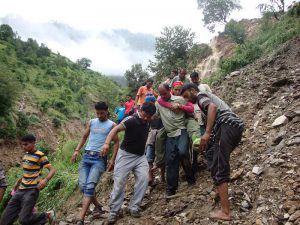A landslide that followed a cloudburst killed at least 68 people in India’s Uttarakhand state. Kashi Nath Vajpai reports.
At least 68 people were killed in a landslide in the Indian Himalayas late yesterday night. Four villages were seriously affected and two more partially affected in the landslide that followed a cloudburst in the upper reaches of the Ganges in the state of Uttarakhand. Some houses in the affected villages were unreachable until dusk the next day, while rescuers desperately worked to remove rubble from other collapsed buildings. Authorities fear that more victims are trapped under the rubble.
This was the second serious landslide within a month in the upper reaches of the Ganges, India’s longest river, considered the holiest by millions of Hindus. The landslide took place around 11.30 p.m., according to residents of nearby villages. The lateness of the hour meant higher casualty figures, as almost everyone was asleep at home.
Eyewitnesses said some houses in the six affected villages – all in Rudraprayag district of the Uttarakhand – were completely buried under mud and rubble.
The area is at the edge of a dense forest, which is part of the Kedarnath Musk Deer Sanctuary, a critical habitat for the endangered deer. One of the most beautiful lakes in the Himalayas – Devaria Tal or Lake of the Gods – is in the area. There were no reports yet as to whether the lake had been affected.
The cloudburst that led to the landslide took people by surprise because they are used to the South Asian monsoon retreating by the end of August or the first week of September in these parts of the central and western Himalayas. Local residents said they had not witnessed such erratic rainfall for 20 or 30 years.
Soldiers of the Indian Army and Indo-Tibetan Border Police carried out the rescue work throughout Friday, joined by many volunteers from villages nearby. The landslide has wiped out the main motorable road next to the affected villages, and ambulances had to stop around 40 kilometres away, waiting for the injured to be brought on stretchers or on the backs of rescuers. One helicopter was used to ferry the wounded to nearby hospitals and bring food and blankets to be distributed to those suddenly homeless.
After the last flood in the area, less than a month ago, there had been widespread criticism of the lack of disaster preparedness by the state government. On Friday, the head of a voluntary organisation based in state capital Dehradun told thethirdpole.net: “Disaster management is only paid lip service in this state.” Ironically, there is a disaster management cell at the district headquarters in Rudraprayag. Local residents pointed out that the cloudburst had taken place a few hours before the landslide, but they were still not given any warning.
Kashinath Vajpai is an environmental specialist and convener of a Pan Himalayan Initiative called Climate Himalaya, based in Dehradun http://chimalaya.org/
Photo by Shri Shankar Vishwanath, Okhimath, Rudraprayag, Uttarakhand, India.

